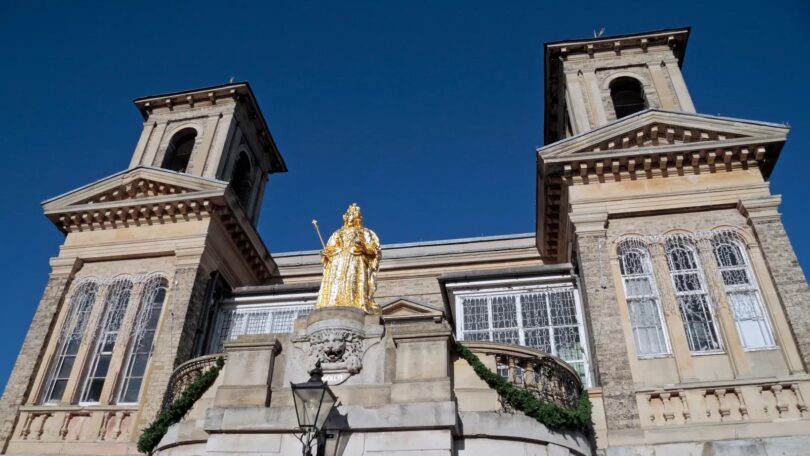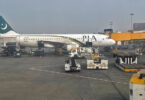Amy McPherson
On an unassuming corner in Kingston upon Thames, an unassuming town on the River Thames, is a stone. It’s no ordinary stone. Protected by a ring of blue iron rails designed to mimic a crown, with seven pillars representing the seven kings whose names are engraved at the base of the stone, this designated historical monument is, according to legend, England’s very own Coronation Stone.
Kingston, as the town is known, is the administrative centre of the eponymous London borough. Its proximity to the famed Hampton Court Palace, Henry VIII’s most famous residence, and favourite filming location for many period dramas such as Bridgerton, makes it a popular transport hub for tourists, though many don’t realise the extraordinary events that took place here.
That’s because Kingston upon Thames is no ordinary London borough. This ancient market town was named the first official Royal Borough of England and is one of the only three royal boroughs in London due to its strong noble heritage.
The town’s Coronation Stone is especially relevant right now, too. With King Charles III’s upcoming crowning, there was a Scottish debate over whether Scotland should transport the Stone of Destiny, the ceremonial coronation stone that is used to crown all British monarchs, to Westminster Abbey this week due to a protest over Scotland being denied another referendum for independence. While the official stone is now in London ready for the coronation, few people know England has its own Coronation Stone right here, in Kingston.
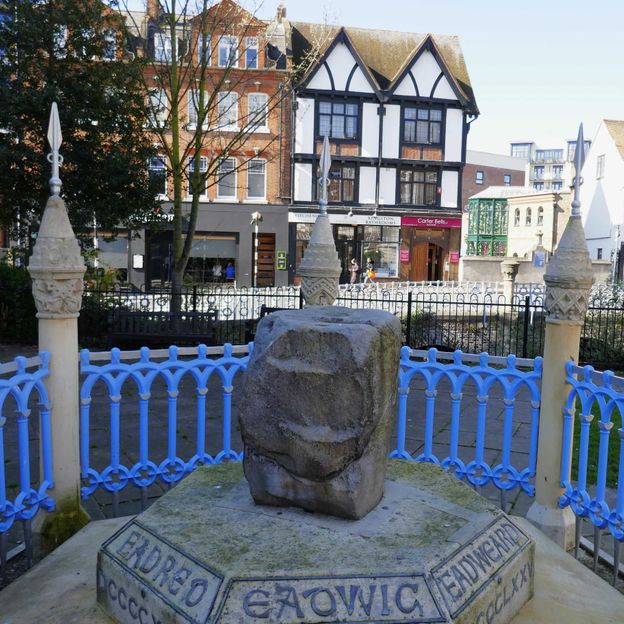
Kingston’s Coronation Stone is believed to have been used in the coronation of seven Anglo-Saxon kings (Credit: Amy McPherson)
Kingston upon Thames’ importance stretches back to the 10th Century when King Athelstan, the most notable Saxon king, was crowned here in 925 CE. Athelstan is regarded as the first King of England, having defeated the Vikings and Scotland alliance at York in the Battle of Brunanburh, unifying a map of the British Isles and marking Kingston as the place where a united England began.
Athelstan’s coronation is thought to have taken place at what is now the site of the current All Saints Church. The location was likely chosen due to its proximity to the border of the ancient kingdoms of Wessex and Mercia, which Athelstan also united as part of his reign. Although no written record of the stone existed until the 1790s, it’s thought that as part of the ceremony Athelstan sat on the Coronation Stone while receiving his crown. A replica of this first crown is on display in the church, constructed from an illustration of the ceremony on 4 September 925.
“So, not only do we have the Coronation Stone, it is possible that it was the act of the first-ever documented coronation in England,” said Julian McCarthy, a volunteer tour guide in Kingston upon Thames.
Kingston remained the favoured site for royal coronations, seeing the crowning of Edred in 946 and Ethelred the Unready in 979, among others; and traditional stories tell that the kings all sat on the same Coronation Stone. Since no further records on the Coronation Stone exist, it is uncertain when and why the stone stopped being used. Yet, one tradition from Kingston has remained: the coronation “ordo” (meaning “order” in Latin), compiled for Athelstan by Athelm (then Archbishop of Canterbury) is still used for coronations of British monarchs, including the coronation of Queen Elizabeth II in 1953, and will likely be used in the upcoming coronation of King Charles III.
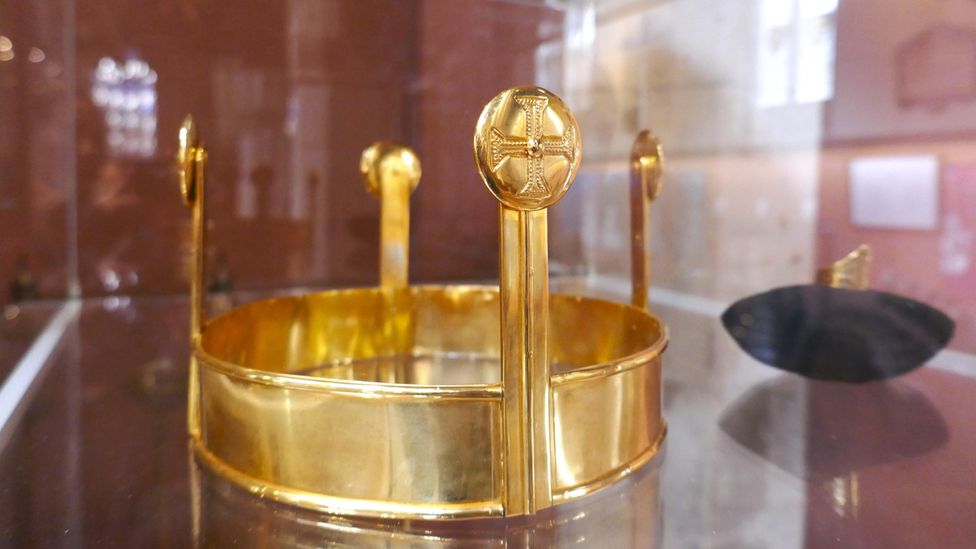
A replica of Athelstan’s crown is on display in Kingston’s All Saints Church (Credit: Amy McPherson)
Walking around Kingston on a free guided tour reveals the borough’s historical royal patronage. Statues of past kings and queens adorn the ancient buildings at the Market Square, and although more than a millennium has passed since the coronations of the Saxon kings at Kingston, the stone remains on display outside the town’s Guildhall as an important symbol of the town’s past.
Strolling over Kingston Bridge offers more stories from the past. Kingston Bridge was once the second place to cross the Thames after London Bridge, and many would have to come this way to access the other side of the river – including any rebels who wanted to overthrow the crown, as Sir Thomas Wyatt the Younger did during the Wyatt Rebellion in 1554. The residents of Kingston attempted to break the original wooden bridge to stop the rebels from reaching the Tower of London. For this loyalty, Queen Mary Tudor gave Kingston a Royal Charter to hold additional market days.
With these deeply rooted royal links, and with Kingston already being known as an unofficial royal borough since the Middle Ages, King George V formally named Kingston a royal borough in 1927. In 1965, Queen Elizabeth ll granted another Royal Charter confirming Kingston’s title as “Royal Borough of Kingston upon Thames”.
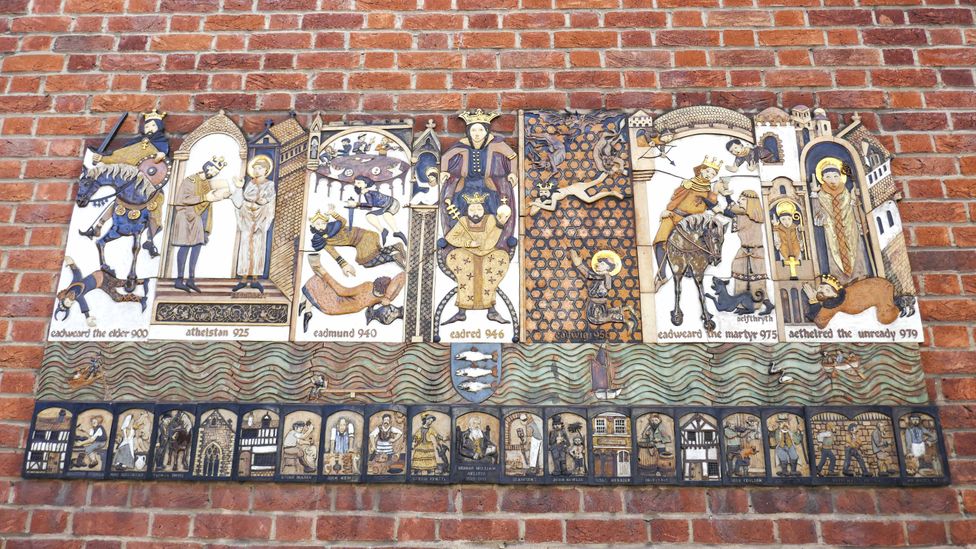
A mural depicts the crowning of kings as well as the River Thames, which played an important role in Kingston’s history (Credit: Amy McPherson)
“We are extremely proud to be the oldest royal borough in the country, the place not only where the first Saxon kings were crowned, but home to the Coronation Stone, which is said to be the site of the coronation of seven Anglo-Saxon kings and the place where England began,” said Councillor Nicola Nardelli, deputy mayor of the Royal Borough of Kingston upon Thames, at a recent ceremony.
We are extremely proud to be the oldest Royal Borough in the country
To celebrate the Coronation, Kingston upon Thames is holding a Coronation Parade on 7 May at the ancient market place, beginning with the parade of King Athelstan’s crown replica, followed by a community band showcasing Kingston’s journey from the past to the present day.
Nardelli added: “With our strong connection to Britain’s royal history, we are looking forward to coming together with our communities next month to celebrate the King’s Coronation, where Kingston’s community spirit will undoubtedly be at the heart of celebrations.”
Courtesy: BBC

